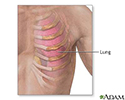Slipping rib syndrome
Interchondral subluxation; Clicking rib syndrome; Slipping-rib-cartilage syndrome; Painful rib syndrome; Twelfth rib syndrome; Displaced ribs; Rib-tip syndrome; Rib subluxation; Chest pain-slipping rib
Slipping rib syndrome refers to pain in your lower chest or upper abdomen which may be present when your lower ribs move a little more than normal.
Your ribs are the bones in your chest that wrap around your upper body. They connect your breastbone to your spine.
Causes
This syndrome usually occurs in the 8th to 10th ribs (also known as false ribs) at the lower part of your rib cage. These ribs are not connected to the chest bone (sternum). Fibrous tissue (ligaments), connect these ribs to each other to help keep them stable. The relative weakness in the ligaments can allow the ribs to move a little more than normal and cause pain.
The condition can occur as a result of:
- Injury to the chest while playing contact sports such as football, ice hockey, wrestling, and rugby
- A fall or direct trauma to your chest
- Rapid twisting, pushing, or lifting motions, such as throwing a baseball or swimming
When the ribs shift, they press on the surrounding muscles, nerves, and other tissues. This causes pain and inflammation in the area.
Slipping rib syndrome can occur at any age, but it is more common in middle-aged adults. Females may be more affected than males.
Symptoms
The condition usually occurs on one side. Rarely, it may occur on both sides. Symptoms include:
- Severe pain in the lower chest or upper abdomen. The pain may come and go and get better with time.
- A popping, clicking, or slipping sensation.
- Pain when applying pressure to the affected area.
- Coughing, laughing, lifting, twisting, and bending may make the pain worse.
Exams and Tests
The symptoms of slipping rib syndrome are similar to other medical conditions. This makes the condition difficult to diagnose.
Your health care provider will take your medical history and ask about your symptoms. You will be asked questions such as:
- How did the pain start?
- Was there an injury?
- What makes your pain worse?
- Does anything help relieve the pain?
Your provider will perform a physical exam. The hooking maneuver test may be done to confirm the diagnosis. In this test:
- You will be asked to lie on your back.
- Your provider will hook their fingers under the lower ribs and pull them outward.
- Pain and a clicking sensation confirms the condition.
On the basis of your exam, an x-ray, ultrasound, MRI or blood tests may be done to check for other conditions.
Treatment
The pain usually goes away in few weeks.
Treatment focuses on relieving the pain. If the pain is mild, you can use ibuprofen (Advil, Motrin) or naproxen (Aleve, Naprosyn) for pain relief. You can buy these pain medicines at the store.
- Talk with your provider before using these medicines if you have heart disease, high blood pressure, kidney disease, liver disease, or have had stomach ulcers or internal bleeding in the past.
- Take the dose as advised by your provider. Do not take more than the amount recommended on the bottle or advised by your provider. Carefully read the warnings on the label before taking any medicine.
Your provider may also prescribe pain medicines to relieve pain.
You may be asked to:
- Apply heat or ice at the site of pain. Wrap the ice in a cloth. Do not put ice directly on the skin.
- Avoid activities that makes the pain worse, such as heavy lifting, twisting, pushing, and pulling.
- Wear a chest binder to stabilize the ribs.
- Consult a physical therapist.
For severe pain, your provider may give you a corticosteroid injection at the site of pain.
If the pain persists, surgery may be done to remove the cartilage and lower ribs, although it is not a commonly performed procedure.
Outlook (Prognosis)
The pain often goes away completely over time, although the pain may become chronic. Injections or surgery may be required in some cases.
Possible Complications
Complications may include:
- Difficulty breathing.
- A pneumothorax from an injury during an injection.
There are usually no long-term complications.
When to Contact a Medical Professional
You should contact your provider right away if you have:
- An injury to your chest
- Pain in your lower chest or upper abdomen
- Difficulty breathing or shortness of breath
- Pain during daily activities
Call 911 or the local emergency number if:
- You have sudden crushing, squeezing, tightening, or pressure in your chest.
- Pain spreads (radiates) to your jaw, left arm, or between your shoulder blades.
- You have nausea, dizziness, sweating, a racing heart, or shortness of breath.
References
Cupit GL, Dixit S, Chang CJ. Thorax and abdominal injuries. In: Madden CC, Putukian M, McCarty EC, Young CC, eds. Netter's Sports Medicine. 3rd ed. Philadelphia, PA: Elsevier; 2023:chap 52.
Kolinski JM. Chest pain. In: Kliegman RM, Toth H, Bordini BJ, Basel D, eds. Nelson Pediatric Symptom-Based Diagnosis. 2nd ed. Philadelphia, PA: Elsevier; 2023:chap 8.
McMahon, LE. Slipping rib syndrome: a review of evaluation, diagnosis and treatment. Semin Pediatr Surg. 2018;27(3):183-188. PMID: 30078490 pubmed.ncbi.nlm.nih.gov/30078490/.
Waldmann SD. Slipping rib syndrome. In: Waldmann SD, ed. Atlas of Uncommon Pain Syndromes. 4th ed. Philadelphia, PA: Elsevier; 2020:chap 72.
Review Date: 10/15/2023







